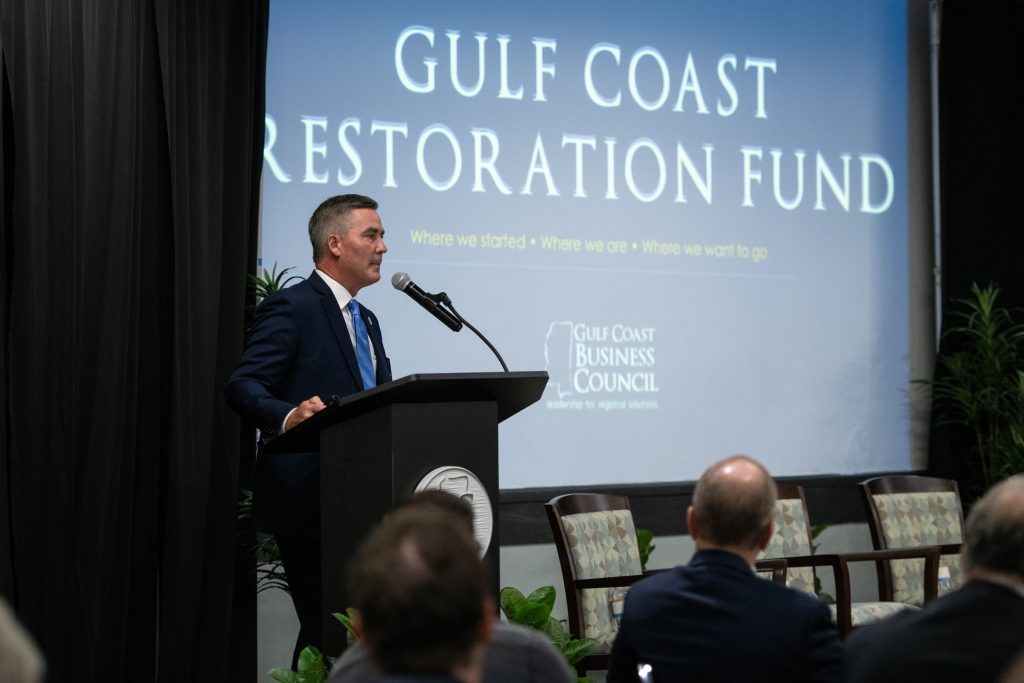Over the summer, the Gulf Coast Business Council continued its dialogue around the Gulf Coast Restoration Fund (GCRF), hosting a series of conversations focused on how we can most strategically invest in the future of Coastal Mississippi. That conversation now moves into a new phase.
Applications for the 2026 GCRF cycle officially closed on August 1st. In total, more than $380 million in funding was requested across a wide range of projects, backed by an additional $263 million in matching funds from private and public partners. These proposals span infrastructure upgrades, healthcare facilities, public amenities, site development, educational programming, and more. However, few proposals could be considered truly transformational in nature.
A Time for Thoughtful Evaluation
As the GCRF Advisory Board begins its formal review, the Gulf Coast Business Council encourages both public and private sector leaders to closely examine the submitted projects—not just in terms of what they are, but in terms of what they could mean for the long-term economic future of our region.
The Council continues to recommend using the Coastal Mississippi Investment Strategy prepared by TIP Strategies as a guiding framework. That strategy calls for investment in three focus areas:
- Foundational Investments: Projects that strengthen our critical infrastructure—ports, airports, utilities, and more—to create the groundwork for future growth.
- Core Economic Development: Efforts that build on existing industry strengths, such as aerospace, shipbuilding, tourism, and healthcare, often through workforce development, site readiness, or regional marketing.
- Transformational Projects: Larger-scale initiatives with the potential to shift the region’s economic trajectory, including innovation districts, Centers of Excellence, revolving loan programs, and venture capital.
Additionally, all proposals should align with one or more of the five guiding principles for public investment outlined in the strategy:
✅ Economic Competitiveness
✅ Quality of Place
✅ Regional Collaboration
✅ Innovation
✅ Resilient Infrastructure
What We Saw—and What We Still Need
The 2026 submissions reflect a broad mix of priorities, including many efforts to address local infrastructure, improve public services, and expand access to healthcare and education.
While community improvement remains a part of the fund’s purpose, transformational investments that drive long-term regional competitiveness, economic diversification, and innovation are needed now more than ever. The GCBC remains committed to advocating for those kinds of projects and encourages future applicants to think big, think collaboratively, and think long-term.
Explore the Submitted Projects
A full list of 2026 GCRF applicants and their proposed projects is available here.
We welcome your thoughts. Which projects do you believe are most aligned with the vision for Coastal Mississippi’s future? Let us know by reaching out or engaging in the comments.
The 2026 Gulf Coast Restoration Fund cycle brought in a wide-ranging set of proposals from cities, counties, school districts, healthcare systems, private developers, and nonprofit organizations. While the projects span the region and reflect diverse needs, a few key trends emerged across industry sectors, geographic distribution, and project types.
Public Infrastructure
Infrastructure projects once again made up a large portion of the submissions. These included road improvements, utility upgrades, sidewalks, public parks, and drainage projects.
- City of Gulfport submitted three projects totaling nearly $12 million, including a Multi-Use Path and Sidewalks plan and a Mast Arm Signal system with pre-emption technology.
- City of Moss Point requested $5 million for downtown infrastructure and renewal.
- City of Lucedale’s Cowart Street Improvements ($2.2M)
- City of Wiggins Hall Street Widening Project ($2.5M)
- City of Waveland’s Waterfront Improvements ($3.8M)
Education
Multiple school districts and organizations proposed new facilities, expansions, and programming.
- Harrison County School District requested $5.7 million for a Career & Technical Workforce Development Program and Facility Expansion.
- Bay-Waveland School District submitted two proposals totaling $10.1 million, including a Career and Technical Education Center.
- Climb CDC in Gulfport requested over $7 million combined for two Climb Academy workforce initiatives.
- Singing River Health System proposed a $2.8 million Healthcare Academy Expansion in Ocean Springs to train the next generation of healthcare workers.
Healthcare and Public Safety
A number of proposals in this cycle focus on healthcare infrastructure and public safety facilities across the region.
- Memorial Hospital requested $21 million for a Multispecialty Center and another $22.5 million for an Intermodal Transportation & Parking Structure to support patient access.
- George Regional Health System submitted two proposals totaling nearly $5 million, including a Health & Rehab Revitalization effort.
- Harrison County Sheriff’s Office applied for $8.6 million to advance Phase II of its Law Enforcement Training Academy.
Economic Development and Site Readiness
Several projects sought to expand the region’s economic footprint.
- The Mississippi Gulf Coast Advanced Research and Development Trust Fund, proposed by Harrison County, stood out for its scale, requesting $30 million for a revolving loan fund.
- Harrison County Development Commission submitted a $4 million request for I-10 & Canal Road site development.
- Long Beach Harbor proposed a $27.4 million Harbor Complex Restoration—the largest single project by total funds requested.
- Visage Production Inc. applied for $4 million to launch a UAS Manufacturing Plant at Stennis Space Center.
Tourism
Several tourism-related proposals were submitted this cycle, reflecting continued interest in expanding the Coast’s hospitality, lodging, and entertainment offerings.
- Ocean Springs’ Pine Island Revitalization project came in at $44 million in total funding (including match), with a GCRF request of $6.5 million.
- Lazy Palm Hotel & Food Hall in Ocean Springs ($5.1M total)
- Copper Llama Distillery ($1.7M)
- River City RV Resort in Moss Point ($120K)
- Marble Springs Hotel ($1.1M)
Science, Innovation, and Research
While a few proposals touched on innovation and next-generation growth, the number of submissions in this category remained limited.
- The USM Research Foundation submitted a $1.2 million proposal for the Gulf Blue Mission Acceleration Connector, aimed at supporting innovation-driven blue tech firms by expanding entrepreneurial programming.
- INFINITY Science Center proposed All for STEAM, and STEAM for All with a modest request of $772,500.
- Startup Gulf Coast, in partnership with private-sector collaborators, submitted an $11.4 million proposal for an entrepreneurship and innovation center at Stennis.
- The University of Southern Mississippi requested $2.5 million to support a Research and Teaching Vessel, bolstered by a $15.5 million match.
Geographic Distribution
Proposals were submitted from nearly every coastal and adjacent county, with a concentration in:
- Harrison County (Gulfport, Biloxi, Long Beach)
- Jackson County (Pascagoula, Ocean Springs, Moss Point)
- Hancock County (Bay St. Louis, Waveland, Kiln)
- Pearl River, George, and Stone Counties also submitted multiple infrastructure, health, and education-focused applications.
Several regional or multi-county proposals were also submitted, including a Virtual Care Network, and efforts by Mississippi State University and the Mississippi Sound Estuary Program focused on workforce and environmental data.
Final Thoughts
While the total volume of applications and funding requests reflect the level of need and ambition across the region, few of the 2026 submissions could be classified as transformational. As we move forward, the Gulf Coast Business Council remains committed to fostering bigger, bolder ideas—projects that not only meet today’s needs but shape tomorrow’s economy.


